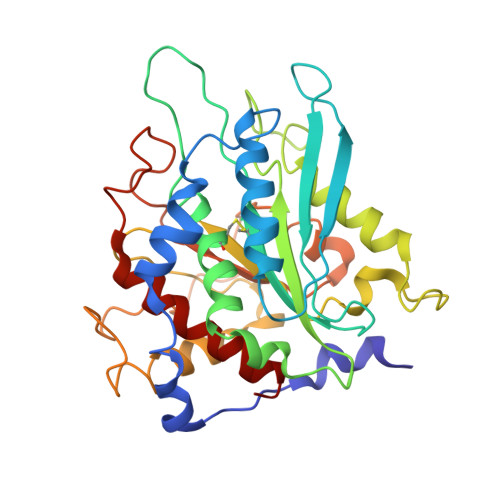Structures of Glycosylated Mammalian Glutaminyl Cyclases Reveal Conformational Variability near the Active Center.
Ruiz-Carrillo, D., Koch, B., Parthier, C., Wermann, M., Dambe, T., Buchholz, M., Ludwig, H.H., Heiser, U., Rahfeld, J.U., Stubbs, M.T., Schilling, S., Demuth, H.U.(2011) Biochemistry 50: 6280-6288
- PubMed: 21671571
- DOI: https://doi.org/10.1021/bi200249h
- Primary Citation of Related Structures:
3SI0, 3SI1, 3SI2 - PubMed Abstract:
Formation of N-terminal pyroglutamate (pGlu or pE) from glutaminyl or glutamyl precursors is catalyzed by glutaminyl cyclases (QC). As the formation of pGlu-amyloid has been linked with Alzheimer's disease, inhibitors of QCs are currently the subject of intense development. Here, we report three crystal structures of N-glycosylated mammalian QC from humans (hQC) and mice (mQC). Whereas the overall structures of the enzymes are similar to those reported previously, two surface loops in the neighborhood of the active center exhibit conformational variability. Furthermore, two conserved cysteine residues form a disulfide bond at the base of the active center that was not present in previous reports of hQC structure. Site-directed mutagenesis suggests a structure-stabilizing role of the disulfide bond. At the entrance to the active center, the conserved tryptophan residue, W(207), which displayed multiple orientations in previous structure, shows a single conformation in both glycosylated human and murine QCs. Although mutagenesis of W(207) into leucine or glutamine altered substrate conversion significantly, the binding constants of inhibitors such as the highly potent PQ50 (PBD150) were minimally affected. The crystal structure of PQ50 bound to the active center of murine QC reveals principal binding determinants provided by the catalytic zinc ion and a hydrophobic funnel. This study presents a first comparison of two mammalian QCs containing typical, conserved post-translational modifications.
- Probiodrug AG, Weinbergweg 22, D-06120 Halle, Saale, Germany.
Organizational Affiliation:


















